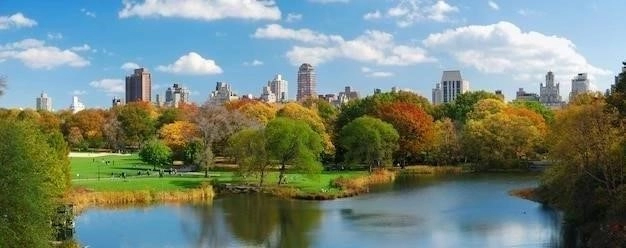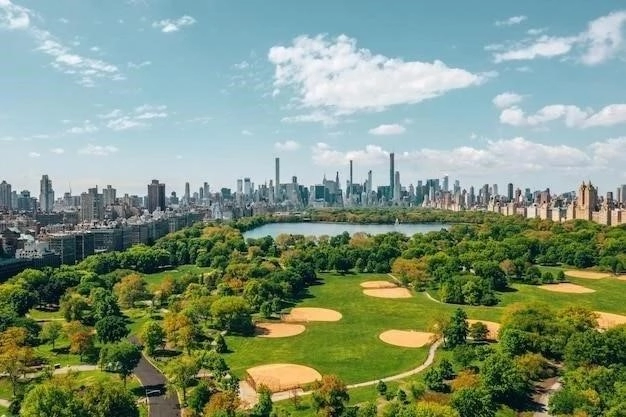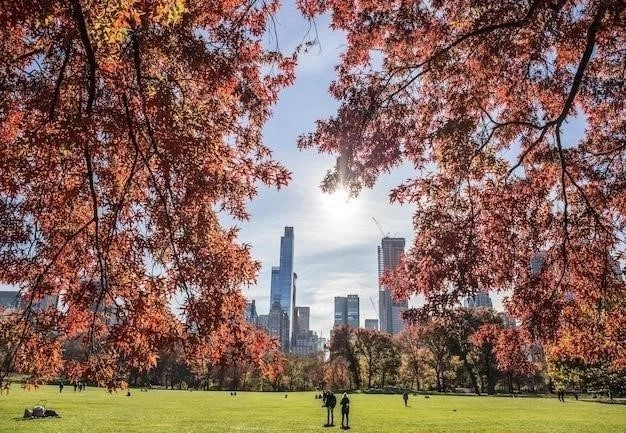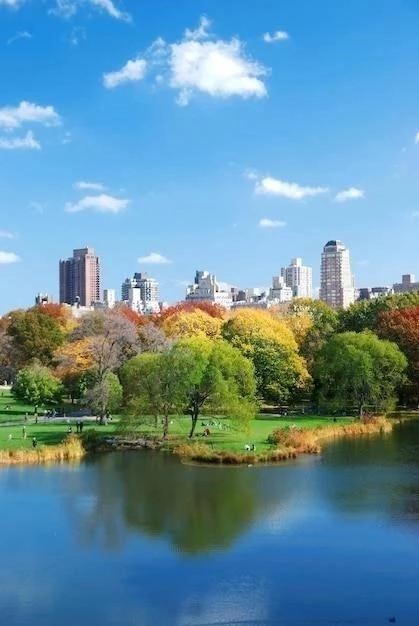Central Park‚ a verdant expanse nestled amidst the towering skyscrapers of Manhattan‚ stands as a testament to urban planning and the enduring human need for nature. This iconic park‚ a masterpiece of landscape architecture‚ offers respite and recreation to millions of visitors each year. This article delves into the rich history‚ design‚ and cultural significance of Central Park‚ exploring its evolution from a visionary concept to a beloved urban sanctuary.

A History Etched in Greensward: From Vision to Reality
The idea of Central Park was first conceived in the mid-19th century‚ a time when New York City was experiencing rapid urbanization. Visionaries recognized the need for a large public park to provide a counterpoint to the citys burgeoning population and relentless development. In 1853‚ the New York State Legislature allocated land for the park‚ setting the stage for its creation.
A design competition was held in 1857‚ attracting 33 proposals. The winning entry‚ titled “Greensward Plan‚” was submitted by Frederick Law Olmsted‚ a writer and landscape designer‚ and Calvert Vaux‚ a British-born architect. Their vision emphasized the creation of a naturalistic landscape that would offer a sense of tranquility and escape from the city.
Construction of Central Park began in 1857‚ a massive undertaking that involved the relocation of communities‚ reshaping of the land‚ and planting of millions of trees and plants. After years of labor‚ the park was officially opened to the public in the winter of 1859‚ forever changing the landscape of New York City.

A Symphony of Design: Olmsted and Vauxs Enduring Legacy
Olmsted and Vauxs Greensward Plan was a triumph of landscape architecture‚ seamlessly blending natural elements with carefully planned vistas and recreational spaces. The parks design philosophy centered around the creation of a “single work of art‚” where each element‚ from the meandering pathways to the picturesque bridges‚ contributed to the overall harmony.
Central Parks design features a variety of distinct landscapes‚ each with its own unique character. The Ramble‚ a 38-acre woodland‚ provides a secluded escape with its winding trails and dense foliage. The Sheep Meadow‚ a sprawling lawn‚ offers ample space for picnicking and sunbathing. The Bethesda Terrace‚ overlooking the Lake‚ is a grand architectural centerpiece that has become a symbol of the park itself.
Olmsted and Vauxs design also incorporated a network of carriage drives‚ transverse roads that traversed the park at a lower level‚ minimizing the disruption to pedestrian traffic and preserving the parks sense of tranquility.

A Cultural Tapestry: Recreation‚ Entertainment‚ and Art
Central Park has served as a vibrant cultural hub for over a century‚ hosting countless events‚ performances‚ and gatherings. The parks numerous stages‚ including the Delacorte Theater‚ which hosts free Shakespeare in the Park performances‚ and the SummerStage‚ which showcases a diverse range of musical acts‚ have become iconic venues.
Beyond its formal performance spaces‚ Central Park provides a stage for impromptu performances‚ from street musicians to amateur theater groups. Its lawns and meadows have hosted legendary concerts‚ attracting hundreds of thousands of music lovers.
The park is also home to an impressive collection of sculptures and monuments‚ each with its own story to tell. The iconic Bethesda Fountain‚ the majestic statue of Balto‚ and the poignant Strawberry Fields memorial to John Lennon are just a few examples of the artistic treasures that grace the park.
A Haven for Wildlife: An Unexpected Ecosystem
Despite its location in the heart of one of the worlds largest cities‚ Central Park teems with an unexpected diversity of wildlife. Its 843 acres provide a sanctuary for birds‚ squirrels‚ turtles‚ and other creatures‚ offering a glimpse of nature within the urban jungle.
The parks diverse habitats‚ from woodlands and meadows to lakes and ponds‚ support a wide range of species. Birdwatchers flock to the Ramble‚ a prime spot for spotting migratory birds‚ while the Reservoir attracts a variety of waterfowl.
The Central Park Conservancy‚ a non-profit organization dedicated to the parks care‚ plays a vital role in preserving its biodiversity through habitat restoration‚ wildlife management‚ and educational programs.
A Timeless Icon: Central Park in the 21st Century
Central Park‚ more than 160 years after its creation‚ remains a vital urban oasis‚ a testament to the enduring power of nature and design. It continues to attract millions of visitors annually‚ offering a respite from the citys hustle and bustle‚ a place for recreation‚ contemplation‚ and connection.
As we look to the future‚ the challenge lies in balancing the parks preservation with the needs of its ever-growing user base. The Central Park Conservancy‚ with its commitment to sustainability and community engagement‚ is leading the way in ensuring that this urban treasure continues to thrive for generations to come.
Challenges and Transformations: Navigating the 21st Century
Maintaining the delicate equilibrium between preservation and accessibility presents an ongoing challenge for Central Parks stewards. The parks popularity‚ while a testament to its enduring allure‚ places significant strain on its infrastructure and natural resources. The Central Park Conservancy‚ alongside the NYC Parks Department‚ employs innovative strategies to mitigate these pressures‚ including:
- Sustainable Practices: Implementing eco-friendly maintenance techniques‚ such as organic land care and composting‚ minimizes the parks environmental impact.
- Restoration Initiatives: Ongoing restoration projects‚ often funded through public-private partnerships‚ address wear and tear‚ revitalize landscapes‚ and enhance biodiversity.
- Visitor Management: Strategies such as timed entry for high-traffic areas and educational campaigns promoting responsible park use help to distribute visitor impact.

A Legacy of Inspiration: Central Parks Global Influence
Central Parks influence extends far beyond the boundaries of Manhattan. Its innovative design‚ rooted in the principles of landscape architecture‚ has inspired the creation of urban parks worldwide. From Londons Hyde Park to Tokyos Ueno Park‚ green spaces designed for recreation and respite now grace countless cities‚ echoing Central Parks transformative vision.
Moreover‚ Central Parks enduring legacy lies in its demonstration of the profound impact public green spaces have on urban life. It serves as a powerful reminder that even amidst the density and dynamism of a global city‚ nature can thrive and enrich the human experience.
A Living Landscape: Central Parks Ever-Unfolding Story
As Central Park enters its next chapter‚ it continues to evolve‚ a dynamic tapestry woven from history‚ nature‚ and human interaction. Each generation leaves its mark‚ contributing to the parks ever-unfolding story. Whether seeking solace amidst the trees‚ engaging in spirited recreation‚ or marveling at the artistry of its design‚ visitors to Central Park become part of its enduring legacy‚ a living testament to the enduring power of nature in the urban realm;










